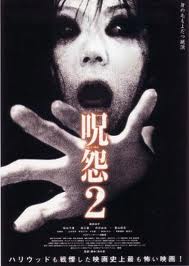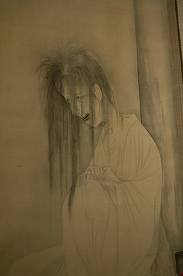 We have all seen the spine tingling ghost videos and blockbuster movies with the infamous “ghost girl” that send shivers down our spine. Movies such as “The Ring” and “The Grudge” found instant popularity in western culture. What many people do not know is that these movies were remakes of Japanese Ghost Movies and were based on actual tradition and accounts of Japanese Ghosts.
We have all seen the spine tingling ghost videos and blockbuster movies with the infamous “ghost girl” that send shivers down our spine. Movies such as “The Ring” and “The Grudge” found instant popularity in western culture. What many people do not know is that these movies were remakes of Japanese Ghost Movies and were based on actual tradition and accounts of Japanese Ghosts.Japan has stories of ghosts and spirits similar to the Western world with spirits and apparitions of the dead appearing to the world of the living. There are many ways that the Japanese refer to ghosts, but most often you will find the term “yurei”. The word yurei is translated to mean “faint spirit”. Tales of the yurei are age old in Japanese culture.
The Yurei are usually described as being pale, with long dark hair that will often cover their face. They are seen wearing white or a white dress with their lifeless arms dangling to their sides. The long dark hair is believed to be connected to the fact that Japanese women throughout history would keep their hair pulled up, but upon death their long hair would be let down for burial. Yurei are said to be without legs and are seen floating. They are also said to sometimes be accompanied by ghostly flames or “hitodama” that can appear in various colors.
cover their face. They are seen wearing white or a white dress with their lifeless arms dangling to their sides. The long dark hair is believed to be connected to the fact that Japanese women throughout history would keep their hair pulled up, but upon death their long hair would be let down for burial. Yurei are said to be without legs and are seen floating. They are also said to sometimes be accompanied by ghostly flames or “hitodama” that can appear in various colors.
 cover their face. They are seen wearing white or a white dress with their lifeless arms dangling to their sides. The long dark hair is believed to be connected to the fact that Japanese women throughout history would keep their hair pulled up, but upon death their long hair would be let down for burial. Yurei are said to be without legs and are seen floating. They are also said to sometimes be accompanied by ghostly flames or “hitodama” that can appear in various colors.
cover their face. They are seen wearing white or a white dress with their lifeless arms dangling to their sides. The long dark hair is believed to be connected to the fact that Japanese women throughout history would keep their hair pulled up, but upon death their long hair would be let down for burial. Yurei are said to be without legs and are seen floating. They are also said to sometimes be accompanied by ghostly flames or “hitodama” that can appear in various colors.It is believed in Japanese culture that yurei will haunt the place of their death and the people responsible for the loss of their life. They are attached to specific places, some of which are said to be the well of Himeji Castle and a forest at the base of Mt. Fuji that has earned a reputation as a place for people to commit suicide. Yurei ar usually witnessed during the Japanese “Witching Hour” which is between 2 and 3 am. It is believed that the separation between the world of the living and the land of the dead is at it’s thinnest during this time. The living are believed to intercede on the behalf of the yurei through various prayers and offerings that can release them to the land of the dead.
Although the term Yurei or “Obake” (to change) is used to refer to all Japanese Ghosts, there are many other classifications of Japanese Haunts. An Ubume is said to be the ghost of a woman who has died in childbirth or who has died while having small children that were left behind in the world of the living. Zashiki-Warashi are the ghosts of Japanese children that are often reported as mischevious, but harmless spirits and an Onryo is a ghost on a mission of revenge against the ones who had wronged the spirit during life. These are just a few ghostly examples and there is much more to learn about the Japanese culture of Ghosts. For those interested you can visit the link below for more information.

